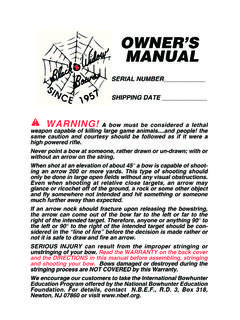Transcription of Redback Spider and Brown Widow Spider Fact Sheet
1 Redback Spider and Brown Widow Spider Fact Sheet Adult female Redback . Image: QM, Jeff Wright. Redback Spider Latrodectus hasseltii The eggs are wrapped in tough layers of silk to form a sac. The Redback Spider is best known from the adult female which These spherical, fawn-coloured sacs are hung near the back of has a smooth, black body with a broad red stripe above and a the web where the female guards them. Each sac contains 40- red hourglass shape or two triangles below. 300 eggs, and three to five sacs are laid at any one time. The young emerge after about 14 days; if conditions are suitable This typical pattern can vary.
2 The Spider may be light or dark they disperse. Each spiderling produces a long thin thread of Brown , and its red stripe, of varying length and width may silk, enabling it to be blown by wind to another site where it will be pink or light orange. In one variation the Spider is almost settle down and build a web. entirely a light yellow- Brown , obscuring and almost masking an orange stripe. The hourglass-shaped marking on the underside is almost always present and is diagnostic of most Widow spiders (Latrodectus spp.) of which the Australian Redback Spider , the Brown Widow , and the American Black Widow are examples. Adult female Redback Spider with egg sac.
3 Image: QM. Redbacks will build almost anywhere with access to a plentiful supply of food and out of the direct effects of the weather: on buildings; under steps; tables and chairs; in grass; under logs;. around pot plants; and in crevices of bricks. The web consists Adult Redback Spider , Lactrodectus hasseltii. of an untidy, irregular tangle of fine, strong silk. Often there are Image: Robert Raven. leaves and the remains of insects caught in the web. The back portion of the web forms a funnel-shaped retreat, where the An adult female Redback has an abdomen the size of a egg sacs are also placed. They prefer locations with the outer pea and legs that may span a 50 cent coin.
4 As egg laying portion of web exposed to some sunlight and the inner funnel in approaches her abdomen expands to about 10 mm in diameter a sheltered, dark recess. and the red stripe tends to fade. Redbacks occur throughout Australia, but are common where The adult males are considerably smaller, do not have an the natural environment has been disturbed. They are a upper stripe, and may be white to Brown with red and white particular problem in newly settled suburbs. markings. They are rarely seen. Small Redbacks suspected Symptoms of a Bite to be males are usually young females. When newly hatched, the young are a dirty-white colour with some patterning.
5 The Most bites are caused by females or young females hourglass-shaped marking is white. The sides of the abdomen misidentified as males. The initial bite is often felt but is of an immature Spider can be entirely white, cream, or Brown apparently painless. Puncture marks are not always evident. In with white diagonal stripes. As a female matures, her body most bites, intense local pain is experienced about 5 minutes darkens and the hourglass marking and the stripe become after the bite. orange or red. The State of Queensland, (Queensland Museum) 2011. Common symptoms (about 40 per cent of cases) include sweating, muscular weakness, paralysis, stiffness, tremors and loss of coordination.
6 Less common symptoms (about 10. per cent of cases) include nausea, vomiting, local redness and swelling, dizziness or fainting, rapid or irregular heartbeat, insomnia, rigours, fever and muscle spasms. The venom is slow acting and serious symptoms should not develop for Adult female Brown about 3 hours. Widow Spider . Image: QM. IN THE EVENT OF A SUSPECTED BITE, SEEK. MEDICAL AID. In the meantime, the first aid recommended by St John's Ambulance is to apply a cold pack or compress over the bitten area, but do not freeze or damage the unprotected skin. Do not use a pressure immobilisation bandage. The best action is to transport the person immediately and without panic to medical aid.
7 An antivenom has been available since 1956 and since then only one death has occurred from Redback bites. Prior to this, 13 deaths were recorded. Control Redbacks are hardy spiders, able to withstand high Brown Widow Spider and egg-sacs. temperatures and prolonged dry periods. Within the web they Image: QM, Gary Cranitch. construct a deep retreat where they will hide if disturbed. The entrance to the retreat usually opens downwards and this, combined with the Spider 's timid behaviour, limits the effectiveness of chemical sprays. Even if the adult Spider is The web is an untidy, irregular tangle of strong silk, formed into killed, the eggs are likely to survive within their tough sac and a deep, tough scoop.
8 The Spider rests with its egg-sacs at the hatch later to recolonise the area. back of the web. As yet, Brown widows have only been found Even if a total kill' is achieved, spraying must be repeated in association with human structures: under tables and chairs;. frequently, as one breeze will carry a new batch of young in car bodies; among paper work on desks; and in the bases spiders in from elsewhere. of pot plants. Chemical sprays are indiscriminate, killing all spiders including The Brown Widow is the most actively reproducing Widow the harmless ones that help control Redbacks. As Redbacks species, producing up to 5000 young per female per season.
9 It are rapid colonisers, spraying may favour them and lead to an appears not to be as adversely affected by winter and has the increase in their numbers. potential to become a considerable pest. The most effective method of Redback control could be termed Symptoms of a Bite informed vigilance'. Learn to recognise Redback Spider 's webs. IN THE EVENT OF A SUSPECTED BITE, SEEK MEDICAL. Take a stick or small brush. Push it quickly into the back of the AID. web as far as it will go and roll the Spider , her eggs and web onto the stick. Crush the Spider and thoroughly crush the egg Apparently, the bite of the Brown Widow does not cause the sac.
10 Areas that have been infested should be checked regularly same severe reactions as that of the Redback . The bite is for any survivors or new infestations. The time for best results extremely painful, with pain lasting for up to 3 days. Bites to is winter when Redbacks are most vulnerable, surviving only young babies, people prone to allergies, and the elderly should where there is sufficient warmth from sunlight. Garden furniture, be given medical attention immediately. and under steps and windowsills are favoured places. Control The roof cavity of homes may act as a reservoir for repeated Both Redbacks and Brown widows live in the same types of infestations.








